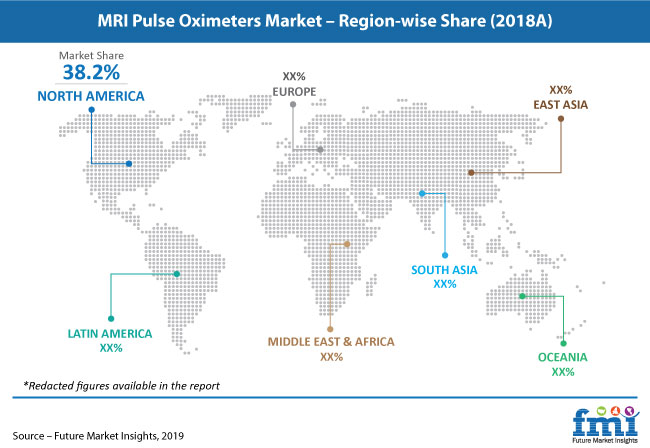
MRI Pulse Oximeters Market Key Players, SWOT Analysis, Key Indicators and Forecast to 2029
Global sales of MRI pulse oximeters were valued at ~US$ 29 million in 2018, and are estimated to record a Y-o-Y growth of ~2% in 2019. As per the research findings of a new study by Future Market Insights (FMI), constant technological advancements in medical devices that target improved efficiency and convenience, have been sustaining the use of MRI pulse oximeters.
However, manufacturers are hard pressed to innovate, as the applicability of highly advanced pulse oximeters extends beyond MRI environments.
Request a Sample of this Report @ https://www.futuremarketinsights.com/reports/sample/rep-gb-10020

Recent developments in medical devices allow for generation of real-time information, track past health records, identify potential issues, and devise effective treatment plans. FMI’s study finds that stakeholders in MRI pulse oximeters market are leveraging new sensor technologies, such as fiber optic SpO2 sensors to avoid conductive pathways, and improve device safety. With the approval of 7T MRI scanners, MRI pulse oximeters will further become the breeding ground for innovations and new developments.
A notable increase in the prevalence of chronic diseases has led to surge in the sales of high-end diagnostic machines, including those for MRI, and CT scanners, which in turn foster the demand for MRI pulse oximeters. Developed with non-magnetic components, MRI-compatible pulse oximeters have been gaining ground in early detection of critical congenital heart defects (CCHD) by accurately measuring the blood oxygen value of a newborn.
FMI study estimates that the MRI pulse oximeters market will register a CAGR of 2.4% during the given timeframe. High costs associated with MRI procedures have been creating a wave of reluctance among healthcare professionals and patients to adopt MRI pulse oximetry testing.
However, increasing popularity of medical tourism and favorable health insurance policies in both developed and developing countries are likely to attract patients towards expensive yet efficient MRI scan therapy, and subsequently drive the sales of MRI pulse oximeters.
MRI Pulse Oximeters – Extending the Traditional Functionality
The new-age medical technologies have transformed the way healthcare professionals and patients participate and interact with each other. Owing to rapid pace of technological advancements in healthcare industry, several medical devices have undergone a paradigm shift, and progressed significantly beyond their initial functions. In recent times, companies have been seeking to make their products stand out in an increasingly crowded market place, and some have invested heavily in design processes and capabilities.
Wireless MRI Pulse Oximeters Capture Significant Shares
Aligning with the rapid development of state-of-the-art medical devices and technologies, market players continue to increase the production of wireless MRI pulse oximeters that need not be connected to MRI machines. Operated through infrared (IR) or Bluetooth technology, wireless MRI pulse oximeters have also witnessed higher innovations and investments as compared to wired variants. As 6 in 10 units of MRI pulse oximeters sold in 2018 are wireless, manufacturers are specifically focused in this category. Additionally, MRI pulse oximeters without monitor continue to account for greater revenue share over their counterparts, as they can be coupled with a wide range of monitors.
According to the study, while business growth strategies remained influenced by the increasing adoption of MRI pulse oximeters in hospitals, manufacturers are working towards capitalizing on diagnostic laboratories and ambulatory surgical centers for expanded customer base. Increasing patient visits in well-equipped laboratories for complete diagnosis of diseases has also led to realignment of these strategies.
Ask An Analyst @ https://www.futuremarketinsights.com/ask-the-analyst/rep-gb-10020
Growth prospects of the MRI pulse oximeters market, as identified by the FMI study, are high in North America. Heavy investments in R&D activities on medical devices and technologies along with favorable reimbursement scenario in the region are likely to offer lucrative opportunities for the market players. In addition, manufacturers are viewing Asia Pacific from target market perspective, considering increasing healthcare expenditure and growing awareness of new medical devices in the region.
The new business intelligence also offers key insights on the competitive scenario in the MRI pulse oximeters market. As per the study, the market shows a high level of consolidation, with top two players including Nonin and Koninklijke Philips N.V. collectively accounting for ~41% revenue share. Filling gaps in their portfolio to master the diagnosis of chronic diseases, rather than focusing solely on one specific product category will be key focus area for the stakeholders.
Key SegmentBy Product Type
- Wired MRI Pulse oximeters
- Wireless MRI Pulse oximeters
By Modality
- Sensor with monitor
- Sensor without monitor
By End User
- Hospitals
- Diagnostic Laboratories
- Ambulatory Surgical Center
By Region
- North America
- Latin America
- Europe
- South Asia
- East Asia
- Oceania
- Middle East and Africa
Buy Complete Report @ https://www.futuremarketinsights.com/checkout/10020
Editor Details
-
Company:
- MARKITWIRED
- Website:
